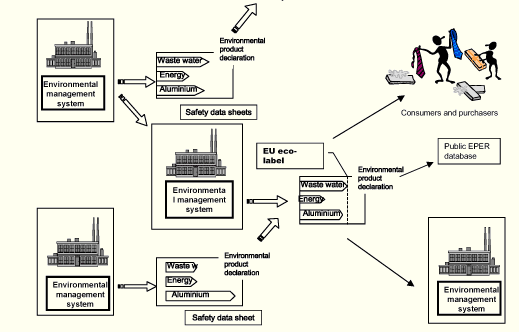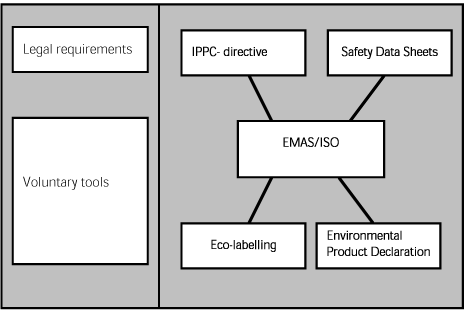|
| Front page | | Contents | | Previous | | Next |
Integrated Supply Chain Information
2 Scope of the study
The scope of the project has been to analyse an ideal work model of a combined organisation of the various schemes for value chain environmental and health information in operation today. This model was
presented by the Danish EPA together with the EUEB Policy Group as the EU informal authority group on Integrated Product Policy (IPP) at meetings during 2001/2002 (fig.1). In addition to the tools
showed in fig. 1 also the regulation regarding safety data sheets and the IPPC directive have been included in the present analysis. This is due to the fact that these directives enforce obligations to inform the
public in general regarding environmental impacts (IPPC) or the professional down stream users on chemical safety precautions (Safety data sheets) – information which is important for the companies'
review of environmental impacts from processes and products in relation to EMAS or ISO 14001. As safety data sheets are included, the analysis has primarily been based on examples in which chemicals
contribute significantly to the environmental and health load of the products.

Figure 1 Combined organisation and flow of information in the value chain
The working hypothesis of the project has been that ideally the flow of life-cycle based information in the value chain should be organized in such a way, that the companies receive adequate and reliable
information from suppliers on the components and materials which the company uses in its own production. By adding the company's own environmental impacts to that of the suppliers, the company can
relatively easily prepare environmental and health profiles for its own products. If desired, the company may relatively easily evaluate whether it is capable of obtaining an eco-labels or an EMAS verification.
The management of environmental and health information should be based on EMAS or ISO 14001 and the basic tool for delivering relevant data up and down the value chain should be a lifecycle-based
environmental product declaration.
An integrated third party verification of the environmental management system as well as the company's environmental product declarations and labels are an important part of the ideal work model.
The combined rationality of the 5 tools is illustrated in figure 2.

Figure 2: The combined rationality of the 5 tools.
Both the IPPC directive and the EMAS regulation focus on the facility, site and industrial activity, while the Eco-label, the EPD and the Safety Data Sheet focus on the product. A direct linkage of scope of
the five systems is therefore not feasible. Only the potential synergy of co-ordinating the management and value chain information obligations of the systems are to be analysed.
The ideal working model as the presented does not exist today and may not be fully applicable. There are areas, however, where further integration could be achieved for the benefit of all users and
stakeholder. Consequently, the overall scope of the analysis is to:
- Identify barriers for achieving a better co-ordination of the 5 schemes
- Identify benefits for the users of a further integration
- Suggest measures for an improved synergy and co-ordination
The analysis is organised as a “two-factor” comparison between the combinations of tools, where an improved coordination seems most beneficial and where some barriers for an increased coordination are
present today:
- IPPC and EMAS (chapter 4),
- EMAS and Eco-label (Chapter 5),
- Eco-label and EPD (Chapter 6) and
- Eco-label and SDS (Chapter 7).
Other combinations relevant to study (Table 1) have been handled briefly in chapter 4-6 (e.g. the analysis of IPPC and EMAS also discusses the contribution of IPPC data reporting in relation to
Eco-labels).
A horizontal analysis of data and verification requirements for all systems and how synergy may be improved are made in chapter 8, and overall conclusions and recommendations are presented in chapter 9.
The 5 different schemes are briefly outlined in chapter 3 for readers not familiar with all the schemes.
Table 1 “Two-factor” analysis included in the present report (black marking)

| Front page | | Contents | | Previous | | Next | | Top |
Version 1.0 February 2006, © Danish Environmental Protection Agency
|